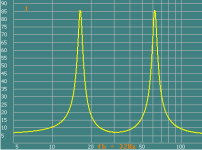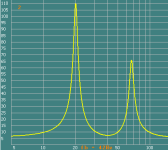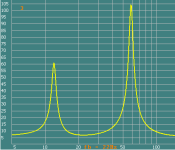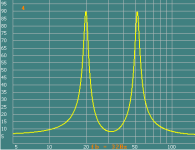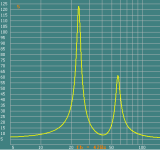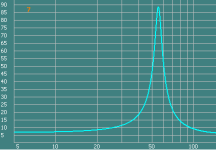Hello,
My question is what determines the Q of first peak of the Vented box system and why?. With my experiments i found that since it is due to resonance of the port and box, it mostly depends on the dimension of the vent and losses in vent .
My question is what determines the Q of first peak of the Vented box system and why?. With my experiments i found that since it is due to resonance of the port and box, it mostly depends on the dimension of the vent and losses in vent .
The lower peak is the so-called port peak. For a given box size and tuning, varying port losses will vary the peak height. Same goes for the upper box peak. Leakage losses will lower both peaks and raise the port minimum.
You will notice that varying tuning will vary the relative heights of the peaks and varying box size will vary the distance between them...
You will notice that varying tuning will vary the relative heights of the peaks and varying box size will vary the distance between them...
Damping the enclosure is the best way to bring down the port impedance peak if this is a problem.
As a slight digression from your question, I used to work with an ex-Mordaunt Short development engineer who helped me build a sub using a 10" Audax drive unit; all the calculations done long hand on a calculator! He advised that Vb should about equal Vas, that the resonance peaks should be about the same height, and that the port area should roughly equal the effective cone area. It worked - ruler flat down to 20Hz with window-rattling capability. This was in 1980 so things have moved on a little, but I have always used these rules of thumb to good effect.
Cheers, Carl.
As a slight digression from your question, I used to work with an ex-Mordaunt Short development engineer who helped me build a sub using a 10" Audax drive unit; all the calculations done long hand on a calculator! He advised that Vb should about equal Vas, that the resonance peaks should be about the same height, and that the port area should roughly equal the effective cone area. It worked - ruler flat down to 20Hz with window-rattling capability. This was in 1980 so things have moved on a little, but I have always used these rules of thumb to good effect.
Cheers, Carl.
As a rule of thumb is it neccesarry to have a first peak equal (or almost equal) to the hieght of the second peak?. If the first peak is damped does it mean that the velocity of air from the port is less.
Equal heights are not necessary. The whole equal heights thing is a persistent relic from the 50's and 60's before people knew about thiele and small's papers.
The relative heights of the peaks (ignoring damping) will depend on the tuning ratio Fb/Fs and this depends on the Qts of the woofer for a given alignment. Detuning an alignment to get equal peaks might work in some cases and be really bad in others.
The relative heights of the peaks (ignoring damping) will depend on the tuning ratio Fb/Fs and this depends on the Qts of the woofer for a given alignment. Detuning an alignment to get equal peaks might work in some cases and be really bad in others.
Here's some examples of how things vary.
T/S of driver = fs = 32Hz - Vas = 206L - Qts = 0.33
Images 1-3 Reflex Box = 103L
Images 4-6 Reflex Box = 206L
Image 7 Sealed Box = 103L
T/S of driver = fs = 32Hz - Vas = 206L - Qts = 0.33
Images 1-3 Reflex Box = 103L
Images 4-6 Reflex Box = 206L
Image 7 Sealed Box = 103L
Attachments
Easy to be addicted to Hornresp and play it like a video game to achieve nice pictures without a functional understanding of acoustics.
For Rice-Kellogg drivers (1924), the impedance curve of a sub reflects back-EMF which is pretty much the motion of the cone which increases dramatically at resonance when the cone goes wild.
If for whatever reason you want a BR box, you need to remember that the upper peak is quite audible (and possibly noxious) because the cone and the port are in phase; but the lower peak far less so because they are out of phase (and also low in frequency). In turn, the desirability of a peak-pattern you choose depends on how low in freq the whole array of peaks (upper and lower) and dips is. A boom at 68 Hz may not be your notion of quality sound.
The big adjustment of port output is when your box is a transmission line with a "port" a few feet long and lined so as to absorb most sound but the main wave. Real nice sound, to my ears.
The final sim above purports to show, I think, the result of putting a nice 22-Hz sub in a 3 cu foot box and thus raising the system resonance to nearly 60 Hz. Does that sound quite right? You often read on this website advocacy of far smaller sealed boxes.
Ultimately, the location of the speaker in your room will very much determine the sound. And that is the sim you want to crank. Good luck finding that help.
Ben
For Rice-Kellogg drivers (1924), the impedance curve of a sub reflects back-EMF which is pretty much the motion of the cone which increases dramatically at resonance when the cone goes wild.
If for whatever reason you want a BR box, you need to remember that the upper peak is quite audible (and possibly noxious) because the cone and the port are in phase; but the lower peak far less so because they are out of phase (and also low in frequency). In turn, the desirability of a peak-pattern you choose depends on how low in freq the whole array of peaks (upper and lower) and dips is. A boom at 68 Hz may not be your notion of quality sound.
The big adjustment of port output is when your box is a transmission line with a "port" a few feet long and lined so as to absorb most sound but the main wave. Real nice sound, to my ears.
The final sim above purports to show, I think, the result of putting a nice 22-Hz sub in a 3 cu foot box and thus raising the system resonance to nearly 60 Hz. Does that sound quite right? You often read on this website advocacy of far smaller sealed boxes.
Ultimately, the location of the speaker in your room will very much determine the sound. And that is the sim you want to crank. Good luck finding that help.
Ben
Last edited:
Let me translate for Ben. paragraph by paragraph....(with parenthetical asides)
Ben doesn't like simulators (who knew? 😉 )
Ben doesn't like vented boxes (but he is correct that the impedance curve reflects cone motion (in fact velocity) which is caused by a coil moving in a magnetic field.)
Ben's comments about impedance peak audibility and this whole paragraph are specious.
Ben doesn't appreciate port output
Ben doesn't understand academic exercises
Ben correctly stresses room acoustics as a major factor. (In fact, they pretty much swamp out the difference between sealed and vented boxes, FWIW)
Easy to be addicted to Hornresp and play it like a video game to achieve nice pictures without a functional understanding of acoustics.
Ben doesn't like simulators (who knew? 😉 )
For Rice-Kellogg drivers (1924), the impedance curve of a sub reflects back-EMF which is pretty much the motion of the cone which increases dramatically at resonance when the cone goes wild.
Ben doesn't like vented boxes (but he is correct that the impedance curve reflects cone motion (in fact velocity) which is caused by a coil moving in a magnetic field.)
If for whatever reason you want a BR box, you need to remember that the upper peak is quite audible (and possibly noxious) because the cone and the port are in phase; but the lower peak far less so because they are out of phase (and also low in frequency). In turn, the desirability of a peak-pattern you choose depends on how low in freq the whole array of peaks (upper and lower) and dips is. A boom at 68 Hz may not be your notion of quality sound.
Ben's comments about impedance peak audibility and this whole paragraph are specious.
The big adjustment of port output is when your box is a transmission line with a "port" a few feet long and lined so as to absorb most sound but the main wave. Real nice sound, to my ears.
Ben doesn't appreciate port output
The final sim above purports to show, I think, the result of putting a nice 22-Hz sub in a 3 cu foot box and thus raising the system resonance to nearly 60 Hz. Does that sound quite right? You often read on this website advocacy of far smaller sealed boxes.
Ben doesn't understand academic exercises
Ultimately, the location of the speaker in your room will very much determine the sound.
Ben correctly stresses room acoustics as a major factor. (In fact, they pretty much swamp out the difference between sealed and vented boxes, FWIW)
Last edited:
How your propensity to regularly pop into threads with such unwarranted condescension hasn't earned you a suspension for trolling is beyond me.Easy to be addicted to Hornresp and play it like a video game to achieve nice pictures without a functional understanding of acoustics.
You cannot hear impedance. The presence of impedance peaks is entirely inaudible unless there are corresponding frequency response peaks.If for whatever reason you want a BR box, you need to remember that the upper peak is quite audible (and possibly noxious) because the cone and the port are in phase; but the lower peak far less so because they are out of phase (and also low in frequency).
+1Ben correctly stresses room acoustics as a major factor. (In fact, they pretty much swamp out the difference between sealed and vented boxes, FWIW)
I'd only add the old proverb, that this challenge provides opportunity to you to match speaker parameters and rooms. But only if you view sound system development as an iterative empirical enterprise not as something readily pre-engineered.
Aside from changing port lengths or "aperiodic" port damping (like Hafler, if I have the term correctly) or drilling a series of holes in back walls of cabs (as i used to do), hard to make variable enclosures. Ideas anybody? I used to add bricks to the small sealed rear enclosure in my Klipshcorn bass.
As I continue to fool with my own room measurements, it becomes clearer to me that the real improvement of boxes, locations, crossover points, slopes, amplification, room treatments, etc. can best be managed as a full system in your specific room.
B.
Last edited:
+1
I'd only add...
In general, it is good practice to at least attempt to address the original poster's question when replying to a thread. Do you have anything to add with regard to factors affecting Q of the lower vented box resonant peak or vented box impedance in general? If not, please go back to motional feedback "research".
Here's some examples of how things vary.
T/S of driver = fs = 32Hz - Vas = 206L - Qts = 0.33
Images 1-3 Reflex Box = 103L
Images 4-6 Reflex Box = 206L
Image 7 Sealed Box = 103L
I would like to ask why this behavior, i can see from the graph that if we tune the box equal to the fs the peaks are equal, if the box is tuned below Fs the first peak is lower and if we tune the box higher then Fs the first peak is higher. Its my understanding that impedance curve reflects the entire electro-acoustic-mechanical system, for sealed box it is easy to understand. It is getting tricky with the bass reflex for me to understand how this parameter are reflected, I mean where and how does the mass in the port, compliance of the system , anti resonance fit all together. I am sorry but i am trying to understand all this phenomena in the forum because some text book and online information dont do justice to explanation they write it simply ok this bass reflex system and it has two impedance peak one is due to port resonance and the other is due to the driver resonance.
There are two subsystems.
1. the driver - sadly, the only ones we can buy have their resonance in the audible range; I don't know why.
2. the cabinet - based on a 19th century genius named Helmholtz, it whistles just like the old coke bottle when you stimulate it by blowing across the top.
The "classical" approach is to tune them to the same frequency so that the box behaviour contradicts the driver behaviour. When you choose the "classical" tuning, the two peaks are the same.
So what the impedance curve is showing is really how the cone is moving in one system. But that system has a dip in the middle where the two subsystems contradict one another.
In post 7 I pointed out that the sound output does not correspond to the cone motion in a BR box. Post 7 might make more sense to you now.
B.
1. the driver - sadly, the only ones we can buy have their resonance in the audible range; I don't know why.
2. the cabinet - based on a 19th century genius named Helmholtz, it whistles just like the old coke bottle when you stimulate it by blowing across the top.
The "classical" approach is to tune them to the same frequency so that the box behaviour contradicts the driver behaviour. When you choose the "classical" tuning, the two peaks are the same.
So what the impedance curve is showing is really how the cone is moving in one system. But that system has a dip in the middle where the two subsystems contradict one another.
In post 7 I pointed out that the sound output does not correspond to the cone motion in a BR box. Post 7 might make more sense to you now.
B.
That sounds like a different model than explanation in post 13? There aren't two peaks in cone motion. Just one with a dip in the middle.The lower peak is the so-called port peak.
But like I said earlier, you don't need a good grasp of acoustics to use a sim - and to use it usefully as a first approximation. Might work for some folks, but not my way of engaging the world of technology.
B.
Last edited:
Lets say i have a restriction in dimension and i need to use a driver with higher resonance frequency because of smaller size, and i tune them below the resonance frequency of the driver. The first peak is significantly damped, but why is this happening , what is going on inside this mass-spring system?The "classical" approach is to tune them to the same frequency so that the box behaviour contradicts the driver behaviour. When you choose the "classical" tuning, the two peaks are the same.
.
OK, that's where you might find yourself.Lets say i have a restriction in dimension and i need to use a driver with higher resonance...
The cone motion (as reflected by impedance) is easy to understand: you have two competing resonance subsystems. If their tuning is staggered, the system nudges the cone motion around as you'd expect. In your case, the lower peak gets worse. The cone is letting-go more.
And with that non-"classic" system, some parameters of sound output can be more-or-less anticipated; but you need a sim because you are going beyond the realm of human brains and tech-intuition (at least for my brain). For some builders, having a handle on some basic parameters may be all they care about.
What isn't as easily anticipated are the consequences of having more cone motion than the "classic" such as influence on distortion, "group delay" (a euphemism for boom), and the general issue of tuned and non-linear elements within the audible band.
The widely sold Altec A7 (the Voice of the Theatre) had non-classic tuning, 70 years ago.
Any of that helpful?
B.
Last edited:
There aren't two peaks in cone motion. Just one with a dip in the middle.
Are you really sure what you talk about?
//
Are you really sure what you talk about?
//
You are correct to ask what is a "peak". For sure, anyone can see two peaks. Something of a question of terminology and I'm sorry if you found my choice was poor. But if you look at the previous post, you'll see that it works nicely to explain the cone motion when there are two subsystems.
B.
Lets say i have a restriction in dimension and i need to use a driver with higher resonance frequency because of smaller size, and i tune them below the resonance frequency of the driver. The first peak is significantly damped, but why is this happening , what is going on inside this mass-spring system?
Why does this matter to you? Ben's explanation is not terribly wrong in a hand-waving sort of way. Funny though, that his explanation in post 16 contradicts both his "model" in post 13 and your experience.
The reason the lower peak is damped in your example is that the motion reducing action of the port on the diaphragm is applied lower in frequency, reducing cone motion below resonance more. When the motion reduction is applied higher, it reduces the upper peak more. The reason the peaks move closer and further with changes in box volume has to do with the "Q" of the port output.
A complicating factor is damping. Damping applied that restricts port flow damps the lower peak significantly. Damping of the box spring affects the upper peak more. This is why the peaks are sometimes referred to as the port and box peaks in the impedance curve.
The impedance curve shape is not a good measure for "tuning" a vented box. Again, why does this matter? To truly explain this well it would take way more time than I wish to spend, with no guarantee that anyone would get anything out of it.
Additionally. IF you make the box too small and tune too low, you may find that your vented box is not much better than a sealed box....
Last edited:
Yes thank you, i will dig more into consequences like distortion and group delay.OK, that's where you might find yourself.
The cone motion (as reflected by impedance) is easy to understand: you have two competing resonance subsystems. If their tuning is staggered, the system nudges the cone motion around as you'd expect. In your case, the lower peak gets worse. The cone is letting-go more.
And with that non-"classic" system, some parameters of sound output can be more-or-less anticipated; but you need a sim because you are going beyond the realm of human brains and tech-intuition (at least for my brain). For some builders, having a handle on some basic parameters may be all they care about.
What isn't as easily anticipated are the consequences of having more cone motion than the "classic" such as influence on distortion, "group delay" (a euphemism for boom), and the general issue of tuned and non-linear elements within the audible band.
The widely sold Altec A7 (the Voice of the Theatre) had non-classic tuning, 70 years ago.
Any of that helpful?
B.
Last edited:
- Status
- Not open for further replies.
- Home
- Loudspeakers
- Subwoofers
- Another question about impedance curve?
